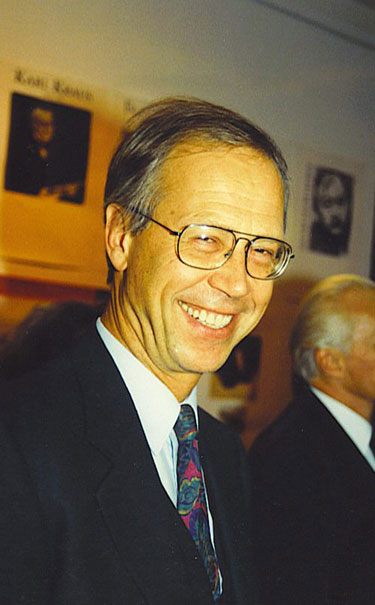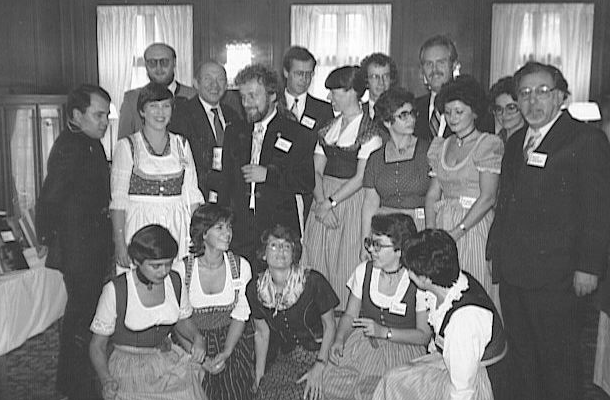The Seventies - A New Generation

Peter Marboe (1970 - 1983)
Peter Marboe began working with the Austrian Information Service in 1970 under Zundritsch and Fenkart, and from 1979 to 1983 served as head of the Press and Information Service. He felt that 1970 was a particularly good time to begin in New York. “Everything seemed on the verge of change. There was a feeling of increasing readiness among Austrian Jewish exiles who had escaped the murderous Nazi regime to reach out to the next generation of Austrians with more confidence. I was, of course, pleased to work as successor to Fritz Molden and Martin Fuchs who had been resistance fighters and to Hugo Portisch who had also been assigned to the Information Service. All of them enjoyed a very good reputation among the Austrian emigrants.“ Nevertheless some skepticism continued to exist within the Austrian Jewish community for decades when in the 1970s a younger generation became active and a new dialogue slowly but steadily opened up.
It was during that time that the American-Austrian Foundation was established with the help of many prominent friends of Austria, including the Honorary Consul General John E. Leslie and many friends of Austria including a number of media representatives. They proved to be very helpful in obtaining appointments for ministers or mayors visiting New York. We also invited representatives from the media to important cultural events, such as the appearance of the Vienna Philharmonic at Carnegie Hall. In turn, we were able to establish a strong network. It was important to me to cooperate closely with the Cultural Institute because one could focus on organizing large-dimensional events “fit for the media,” such as art exhibitions, film festivals, music festivals, symposia, etc. In cooperation with the Consulate General, the annual National holiday was presented with content in mind, targeting cultural and informational events featuring public lectures, films, discussions and invitations to schools, etc.”
On the front page of the New York Times, a renowned barometer of public opinion, Austria appeared on the average four times per year. Politically, the big media “teasers” were articles covering Gadaffi’s visit to Vienna (at the time U.S. public enemy number one), the Kreisky-Peter-Wiesenthal conflict, featured on the front page, as well as coverage of the Lipizzaner or the Vienna Boys Choir. “After the closing down of Schönau Castle (a transit camp for Jewish Emigrants who came from the Soviet Union) under Kreisky, and after a prior, friendly “warning,” our office was even occupied for a short while, something to which ABC gave extensive coverage,” Marboe recalls. In 1982 the “front page stories” covered the Polish refugees, the tour of the U.S. by the Spanish Riding School and Kreisky’s Middle East policy. In 1983 it covered the Lippizaner infected by a virus, a leading article dedicated to Kreisky’s resignation, the Pope’s visit and the peace demonstrations in Vienna.
The challenge was enormous, explaining to the Americans – either directly through lectures, visits to schools, public readings, etc. or indirectly through the media - that there was a new Austria. This meant reporting information devoid of clichés, embellishment or typical images while at the same time remaining open to discussion, particularly when speaking about the years of National Socialism. For that reason, there was also a pressing need to “involve the country’s media by having them convey the new image of Austria, seizing every opportunity to include interviews taken from leading newspapers and magazines, but also television and radio station reports with personalities representing the fields of politics, science, culture, economics and sports“. Television time was purchased from local television stations in order to reach, by way of syndicate texts compiled by the editorial staff, millions of viewers with “newsworthy” news from Austria.
As to the media, a new radio program was introduced under Marboe: the bi-monthly “Welcome to Austria” with ‘News and Views from Austria’ containing interviews, music, etc. It was distributed by the Broadcasting Foundation of America to more than one hundred radio stations. Radio broadcasts, such as “Welcome to Austria,” reached well over one million listeners. “Thus, we had not only achieved maximum distribution but also had the opportunity to continually bring the latest news coverage from and about Austria and to invite many prominent visitors from Austria for interviews.” Official trips included travel throughout the country holding interviews at local radio and TV stations. This was very well received since it involved conversations with local media which were broadcast by the popular talk shows. “Upon my suggestion the name of Information Service was changed to Press and Information Service, which better reflects our media and public relations activities.”
Part of media work consisted in analyzing published newspaper articles in order to determine in which medium and to what extent Austria-related issues were being covered. As Marboe recalls, “we also began writing questionnaires and compiled a yearly clipping service consisting of 15,000 newspaper articles, which we closely analyzed in order to determine where Austria never appeared at all, where it appeared regularly and what the issues were.
For decades Austria’s image fluctuated between the extremes of a shattered world depicted in “The Third Man” and the illusionary harmony portrayed in the “Sound of Music.” Everywhere one spoke about the good old times, much like an aging film star or a former boxing champion. The tourist trade was for years the strongest factor in building Austria’s image, and it was just as well. Nostalgia is always easier to present than economic growth or problems with the environment. One sat on a goldmine. Whether the appeal of Mozart’s music or the psychoanalysis of Sigmund Freud or the warm invitation of the suntanned Tyrolean skiing teacher or the radiant woman, dressed in white at a Vienna ball, these images captured the public imagination. The temptation to find satisfaction in this image full of clichés was indeed great, and all the more so when we were immensely envied by other countries for this very reason. Apart from those world regions in the midst of a crisis, there were few countries covered as well in American publications as Austria. In the New York Times, there were on the average over twenty articles annually. And what were the topics? – The “Magic Flute” performed in Salzburg, the Vienna Philharmonic, the Volks Opera, the Vienna Festival, the Vienna exhibition debuting at the Biennale in Venice and the Albertina. Of the 15,000 articles, which appeared every year on Austria in some 1,200 daily and weekly newspapers, magazines and journals, more than two-thirds were dedicated to topics on culture and tourism. Sixteen percent reported about current (including political) events; five percent targeted the country’s economic development, and 0.5 percent of all the articles were related to science and research.”
As Marboe also recalls, there was the issue of neutrality, which was received rather negatively by the public. “It was very difficult to present a positive picture when compared to Switzerland or Sweden. Why does the media write about the economy of Switzerland and Sweden but rarely about that of Austria; and why is the term ‘Austrian Literature’ categorized under the heading of ‘German’ more often than that of the Swiss? The simple answer appears to be that the “Republic of Austria,” is newer and significantly more complex, including the dark period of National Socialism and the Second World War. It is difficult to explain this complexity when compared to Sweden and Switzerland, whose borders, constitutions and national identities remained unchanged for decades, even centuries.” There was also the problem of Austria being mistaken for Australia and vice versa. After Austria’s legendary soccer victory over Germany at the World Championship in Argentina in 1978, some media wrote: “For the first time in 48 years, Australia beats Germany in soccer.” Other articles confusing the two countries claimed that the USA imported most of its uranium from Austria, and that there was a wine scandal in Australia. The Consul General of Australia called with great concern that Australia’s wine exports had dropped by 30%!
----
Dr. Peter Marboe began his professional career in 1967 in the cultural department of the Austrian Federal Press Service. In 1969 he was secretary of Federal Chancellor Josef Klaus. As of 1970 he was assigned to New York and worked initially at the Austrian Press and Information Service in New York. In 1979-1984 he served as head of the Press and Information Service and 1984-1987 as head of the Cultural Instiute in New York. From 1987 to 1991, he was the Deputy Secretary General of the Austrian People’s Party, and from 1991 to 1996, he was head of the Cultural Policy Section in the Austrian Foreign Ministry. From 1996-2001 he served as City Counselor for Culture in Vienna. One of the major projects during this time was the restoration of Vienna’s Judenplatz. He remained a member of the government of the City of Vienna until 2003. Following the end of his political career, he was named artistic director of Vienna Mozart Year 2006. Marboe is author and editor of numerous publications and contributions on cultural policy and European issues.

